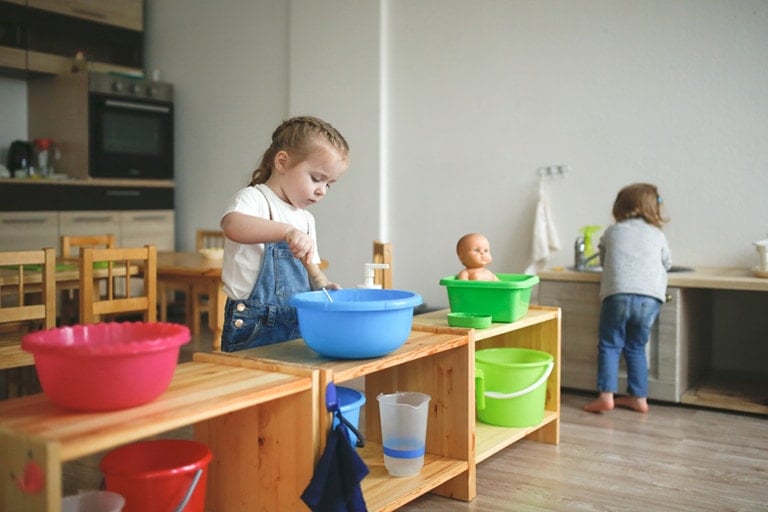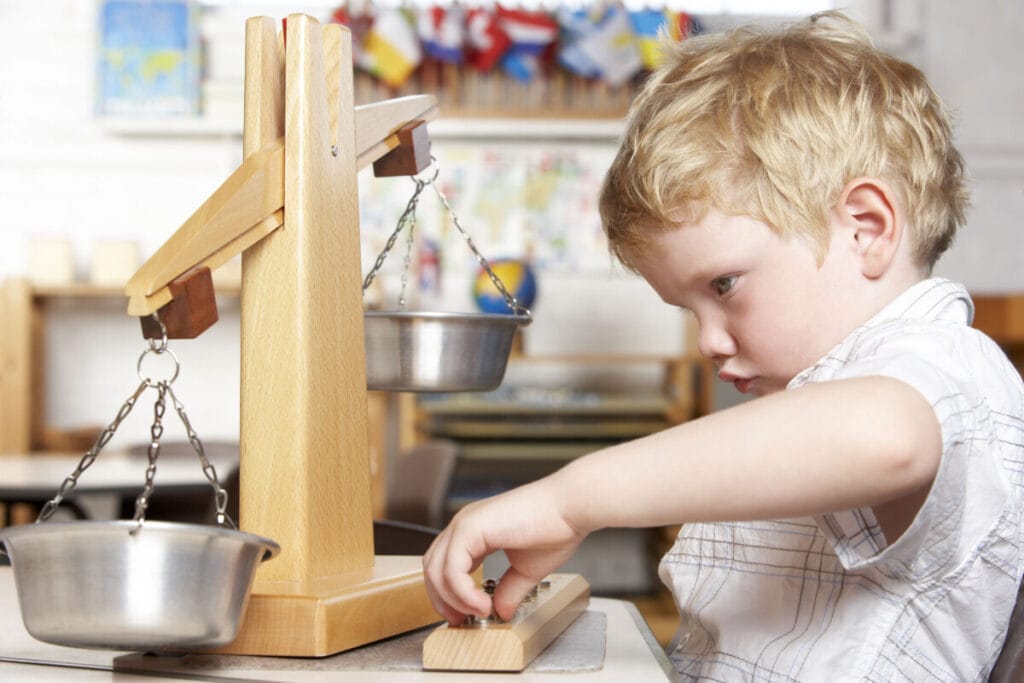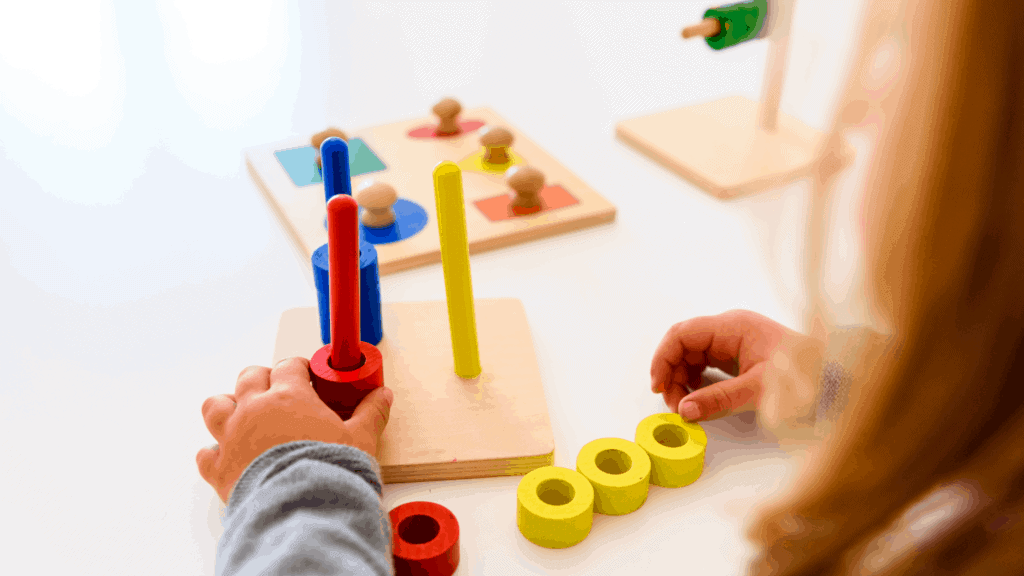The 6 developmental stages of play are unoccupied play, solitary play, onlooker play, associative play, parallel play, and cooperative play. The developmental stages of play are based on a child development theory that describes different types of normative play for different developmental stages.
In
So, what are the developmental stages of play and how do they relate to
On This Page…

What Are the Stages of Play?
The developmental stages of play were first developed all the way back in 1929 by researcher and sociologist, Mildred Parten Newhall. The fact that this theory is still being used today proves that it has truly stood the test of time.
In Parten’s theory, she describes six different types of play that correspond with six different developmental stages. Each stage helps children build the skills they need to move to the next stage. These stages of play can help parents, caregivers, and teachers understand how their children are developing and what skills they are learning through play.
The Developmental Stages of Play
Below are the six developmental stages of play as outlined in Parten’s theory.
Before reading, however, it’s important to know that all children develop at their own rate.
It might be tempting to use these stages of play as a metric for whether or not your child is developing “normally,” but that’s not their intended use. Instead, these stages can help you better understand your child’s behavior and learning needs. If your child is “behind” or “ahead” of the developmental stage typical for their age range, don’t take that as a judgment on their intelligence or abilities, but instead as a point of data to better help you meet their needs.
Unoccupied Play:
Unoccupied Play typically occurs in the first few months of a child’s life (birth – 3 months). During this stage, infants will observe the world around them, move their bodies in different ways, and handle different objects. While this might not look much like play to us as adults, these simple activities are highly stimulating to infant minds. This type of play helps infants develop spacial awareness and awareness of their bodies and the outside world.
Solitary Play:
Solitary Play generally begins when a child is still very young, immediately following Unoccupied Play, and continues into the early toddler years (birth – 2 years). During this stage, babies and toddlers will engage in focused play alone. They will likely not appear to notice or engage with others who are trying to play with them or who are playing nearby. This is entirely normal for this stage.
This type of play helps children build attention, focus, stamina, and new motor/cognitive skills. (If your child is much older than two but often plays alone, don’t fear! This stage describes a particular type of play in which the child playing does not appear to notice or be interested in anyone around them; it does not simply mean a child is playing by themselves.)
Onlooker Play/Behavior:
Around the age of two, children begin to notice the people around them. During this stage, toddlers will begin watching other people play without appearing interested in joining in. Some parents see this and worry that their child is shy or scared, but that isn’t the case at all! Instead, children engaging in Onlooker Play are simply curious about what they’re seeing. They are learning through observation and building an awareness of other people and social structures/norms.
Parallel Play:
Parallel Play generally appears around ages 2-3. It’s no wonder children go through the “Terrible Two’s”; there’s so much going on in their minds at this time! During this stage, children become interested in playing near each other and mimicking each other, but do not engage each other directly in play. You might see two toddlers sitting next to each other on the floor of a playroom playing with similar toys and each copying the other’s actions, but never directly communicating. This type of play is like a more interactive form of Onlooker play where children are learning social skills through observation and independent practice.
Associative Play:
Associative Play tends to appear around ages 3-4. During this stage, children begin engaging others in playing together, but without organization or coordination. Children at this stage are technically playing together, but it looks more like they’re playing at each other instead of with each other. If you’ve ever had preschoolers or worked in a preschool classroom, you probably know exactly what this looks like. It’s chaos! But it is also an important stage that helps children learn about collaboration, cooperation, and communication.
Cooperative Play:
Cooperative Play is an important milestone that most children reach between the ages of 4 and 6. This is when children begin playing more complex games in full collaboration with each other. In this stage, children are just as interested in the people who are playing with them as they are in the games themselves. While this stage is called “Cooperative Play,” it might look like anything but!
There’s lots of conflict between children during this stage as they try to navigate truly playing together. This makes sense – playing together means working together to establish tasks, rules, goals, and organizing principles. It’s tough work and it often leads to anger and hurt feelings. That’s completely normal.
In fact, it’s better than normal – it’s great! This is because this type of conflict helps children learn important lessons and skills around collaboration, problem-solving, effective communication, leadership, listening, navigating rules and guidelines, group identities, and much, much more.
So, how do these stages of play relate to
How Do the Stages of Play Relate to Montessori ?
The research and theories behind the
So, it should be no surprise that the
The Planes of Development can be thought of almost as an extension of the developmental stages of play. There are four planes, each describing one stage of a person’s life as they grow into adulthood. The four planes are:
- Early Childhood (Birth – Age 6): “The Absorbent Mind.” This is the time when a person is primed to absorb the most information. In this period, a young child develops a basic understanding of the world around them and their place in it.
- Childhood (Ages 6 – 12): “The Reasoning Mind.” This is the time when a person begins developing a critical consciousness and an interest in questions of “why” and “how.” Children in this stage become more curious about ideas, choices, decisions, and judgements.
- Adolescence (Ages 12-18): “Development of Social Consciousness.” This is the time when a person becomes concerned with ideas of “I,” “You,” “We,” and “Them.” Children and teenagers in this stage are most interested in personal and group identity and begin to care about and understand the relationship between individuals and society as a whole.
- Young Adulthood (Ages 18-24): “Transitioning to Adulthood and Maturity.” This is the time when a person becomes focused on independence and their life path. Young adults at this stage begin thinking seriously about how to make meaning of their loves.
Sensitive Periods describe times in a child’s development in which they are most receptive to learning particular skills. So, we can think of Sensitive Periods as an expansion of the developmental stages of play, providing more detailed information about what and how your child is learning.
According to the
Overall, the developmental stages of play and related







